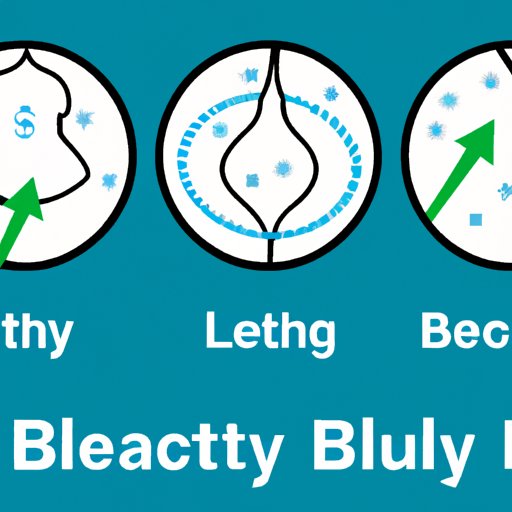
I. Introduction
Most of us don’t pay much attention to our belly buttons beyond cleaning them during showers. But did you know that your belly button can actually be a tell-tale sign of your health? From the types of bacteria that reside within it to the amount of lint that accumulates, your belly button can indicate a lot about your overall well-being. In this article, we’ll explore what your belly button says about your health and why you shouldn’t ignore any warning signs.
II. Exploring the Science: What Your Belly Button Reveals About Your Health
Before we dive into the health conditions that can be indicated by your belly button, let’s start with some basic science. The purpose of the belly button is to mark the spot where your umbilical cord was attached at birth. But beyond that, belly buttons come in various shapes and sizes, from shallow to deep, and can even be an “outie.” These differences can affect the likelihood of certain health conditions.
For example, people with deep belly buttons may be more prone to bacterial infections, as moisture can get trapped in the folds. A shallow belly button, on the other hand, may be less likely to collect bacteria or accumulate lint.
III. Digging Deeper: The Surprising Connection Between Belly Button Bacteria and Your Overall Health
You may be surprised to learn that your belly button is actually a breeding ground for bacteria. But before you run to grab the antibacterial soap, it’s important to understand that not all bacteria are bad. In fact, our bodies are home to trillions of bacteria, known as our microbiome. This microbiome plays a crucial role in our overall health by helping to digest food, breaking down toxins, and even supporting our immune system.
So, what types of bacteria can be found in your belly button? Studies have shown that it’s a diverse mix, including both beneficial bacteria such as Staphylococcus epidermidis and potentially harmful bacteria such as Corynebacterium spp. and Streptococcus spp.
However, when there is an imbalance in this bacterial ecosystem, it can lead to health issues. An overgrowth of certain bacteria may result in infections, while a lack of beneficial bacteria can leave our immune system weakened.
IV. The Belly Button Test: How to Tell If You’re at Risk for Health Issues
One way to gauge your risk for potential health issues related to your belly button is to perform the “belly button test.” This involves examining your belly button for any unusual characteristics, such as redness, discharge, or a foul odor. These may indicate an infection or other underlying condition that warrants medical attention.
Other risk factors to be aware of include obesity, diabetes, and having a history of surgery or piercings in the belly button area. These factors may increase your risk of infection or other health issues related to your belly button.
V. What Your Belly Button Lint Says About Your Health
Now, let’s talk about belly button “lint.” Yes, you read that right. Many people have noticed a buildup of fuzz-like material in their belly buttons. But what exactly is this stuff and what does it reveal about our health?
First of all, belly button lint is a combination of dead skin cells, hair, and clothing fibers that collect in the area. While it’s generally harmless, excessive lint buildup may indicate poor hygiene or a lack of air circulation. In rare cases, it may be a sign of a medical condition such as a fungal infection or a cyst.
To prevent excessive lint buildup, make sure to clean your belly button regularly and wear loose-fitting clothing that allows air to flow through.
VI. Why You Shouldn’t Ignore Your Belly Button: Warning Signs of Health Problems
As we mentioned earlier, unusual characteristics such as redness, discharge, or a foul odor may indicate an infection or other underlying health issue. But there are other warning signs to watch for as well.
If you experience pain or discomfort in your belly button area, this could be a sign of an umbilical hernia. Other symptoms may include swelling or a lump in the area. Additionally, unexplained bleeding or a rash may indicate a skin condition such as psoriasis or eczema.
If you notice any of these warning signs, it’s important to consult with a healthcare professional for proper diagnosis and treatment.
VII. The Importance of Belly Button Hygiene for a Healthy Body
To keep your belly button healthy and free from potential infections, it’s important to maintain proper hygiene. This means cleaning your belly button regularly with soap and water, and drying it thoroughly afterwards. If you have a deep belly button, consider using a cotton swab to reach all the nooks and crannies.
It’s also a good idea to avoid touching your belly button unnecessarily, as this can introduce dirt and bacteria into the area. And if you have a piercing or other opening in your belly button, be extra vigilant about keeping it clean to prevent infections.
VIII. Beyond Aesthetics: The Hidden Health Benefits of a Clean Belly Button
Believe it or not, maintaining a clean belly button can have some surprising health benefits. For example, by keeping the area free from excess bacteria and lint buildup, you reduce your risk of infection and other related conditions.
Furthermore, because the microbiome in our belly buttons is connected to our immune system, keeping it healthy can help to boost our overall immunity. So, don’t neglect your belly button hygiene!
IX. Conclusion
Your belly button may seem like a small and insignificant part of your body, but it can actually reveal a lot about your health. By understanding the science behind belly buttons and maintaining proper hygiene, you can reduce your risk of related health issues and improve your overall well-being.





